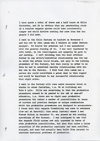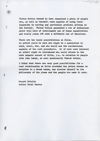

Transcript
APG/Hille Project
Report on APG artist’s visit to Hille factories.
STUART BRISLEY’S REPORT FOLLOWING VISITS TO HILLE FACTORIES…
I have spent a total of three and a half hours at Hille factories, and it is obvious that any penetrating study of a complex organic system would take considerably longer and would involve meeting far more than the two people I did meet.
I went to the Hille factory at Watford on November 6 and was met by John Lewak, who I believe is under factory manager. We toured the premises and I was acquainted with the general running of it. I was very impressed by John Lewak, by his intelligence and sympathy he gave to our meeting. I left thinking that the most critical factor in any artist/industrial relationship was the way in which the artist could relate, not only to the working procedure of the factory, but that really in order to do this he had to establish healthy relationships with the key men in the factory. I felt that John Lewak was a person who could contribute a great deal in this regard and would be important to any successful relationship that might arise.
I went to the factory with some naïve concepts based on visits to other factories, i.e. VW at Wolfsburg and Tate & Lyle. Hille was surprising in that the production procedures seemed to be geared to the odd or one-off situation, i.e. there are no rigid mass production procedures but rather a number of possibilities in terms of current and previous designs or unique commissions which the production procedures are designed to accommodate. I found that this organic flexibility was more in evidence (for me) at Haverhill – the metal factory – where I met Victor Bolton on December 17, who showed me the working operations of the factory. I was intrigued to see that the organic fluid system not only operated in terms of wide production possibilities, but also that quite a large proportion of the production machinery had been modified, changed, and some had actually been built from scratch to overcome technical problems of production.
Victor Bolton seemed to have organised a group of people who, as well as himself, were capable of using their ingenuity in solving any particular problems arising in the factory. Victor Bolton generated a lot of enthusiasm about this kind of intelligent use of human capabilities and really poses APG with a difficult set of decisions.
There are two basic possibilities at Hille. An artist could be sent who might be a specialist in wood, metal, etc. and who would use the conventional aspects of the work procedures. Or of much more interest, an artist might be introduced who could relate to the more organic aspect of Hille, i.e. in relation ot people like John Lewak, or more practically Victor Bolton.
I think that there are very good possibilities for a real relationship at Hille provided the artist chosen is creative in a broad sense, can involve himself in the philosophy of the place and the people who make it work.
Stuart Brisley
Artist Panel Member